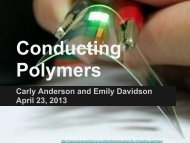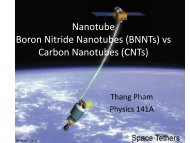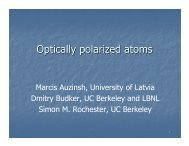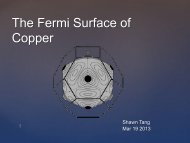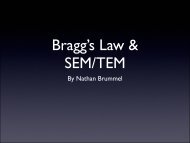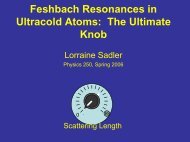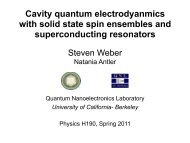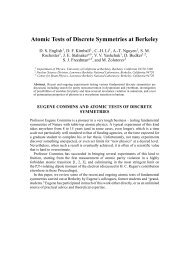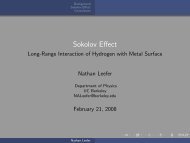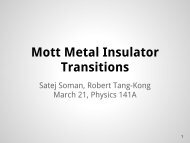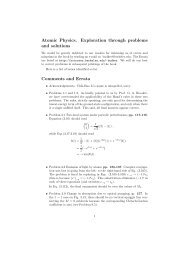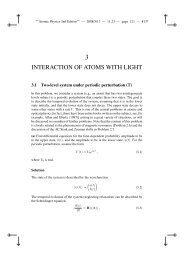Resonant nonlinear magneto-optical effects in atomsâ - The Budker ...
Resonant nonlinear magneto-optical effects in atomsâ - The Budker ...
Resonant nonlinear magneto-optical effects in atomsâ - The Budker ...
You also want an ePaper? Increase the reach of your titles
YUMPU automatically turns print PDFs into web optimized ePapers that Google loves.
29<br />
Faraday rotation φ (mrad)<br />
5<br />
0<br />
<br />
<br />
<br />
φ (mrad)<br />
<br />
<br />
Longitud<strong>in</strong>al magnetic field B z (G)<br />
<br />
5<br />
B z (ΜG)<br />
FIG. 17 Longitud<strong>in</strong>al magnetic field dependence of <strong>optical</strong><br />
rotation <strong>in</strong> a paraff<strong>in</strong>-coated 85 Rb-vapor cell (<strong>Budker</strong> et al.,<br />
1998a). <strong>The</strong> background slope is due to the Bennett-structure<br />
effect. <strong>The</strong> dispersion-like structure is due to the transit effect.<br />
<strong>The</strong> <strong>in</strong>set shows the near-zero B z -field behavior at a<br />
2 × 10 5 magnification of the magnetic field scale. Light <strong>in</strong>tensity<br />
is ∼100 µW cm 2 . <strong>The</strong> laser is tuned ∼150 MHz to the<br />
high frequency side of the F = 3 → F ′ absorption peak.<br />
micron-sized droplets fall<strong>in</strong>g through the gas (see also<br />
discussion by Kimball et al., 2001).<br />
E. Antirelaxation-coated cells<br />
Antirelaxation-coated cells provide long sp<strong>in</strong>relaxation<br />
times due to the greatly reduced rate of<br />
depolarization <strong>in</strong> wall collisions. Three <strong>nonl<strong>in</strong>ear</strong> <strong>effects</strong><br />
can be observed “nested” <strong>in</strong> the magnetic-field dependence<br />
of NMOR produced by such a cell (Fig. VIII.E).<br />
<strong>The</strong> widest feature is due to Bennett-structure effect<br />
(Sec. V.A), followed by the feature due to the transit<br />
effect, which also occurs <strong>in</strong> uncoated cells (Sec. VIII.A).<br />
<strong>The</strong> narrowest feature is due to the wall-<strong>in</strong>duced Ramsey<br />
effect, a variant of the separated-field transit effect <strong>in</strong><br />
which atoms leave the light beam after be<strong>in</strong>g <strong>optical</strong>ly<br />
pumped and are later probed after collid<strong>in</strong>g with the<br />
cell walls and return<strong>in</strong>g to the beam.<br />
1. Experiments<br />
In their early work on <strong>optical</strong> pump<strong>in</strong>g, Rob<strong>in</strong>son et al.<br />
(1958) showed that by coat<strong>in</strong>g the walls of a vapor cell<br />
with a chemically <strong>in</strong>ert substance such as paraff<strong>in</strong> (chemical<br />
formula C n H 2n+2 ), the relaxation of atomic polarization<br />
due to wall collisions could be significantly reduced.<br />
Recently, work<strong>in</strong>g with a paraff<strong>in</strong>-coated Cs vapor cell,<br />
Kanorskii et al. (1995) discovered a narrow feature (of<br />
width ∼1 mG) <strong>in</strong> the magnetic-field dependence of Fara-<br />
<br />
day rotation. Kanorskii et al. (1995) described the feature<br />
as a Ramsey resonance <strong>in</strong>duced by multiple wall<br />
collisions. 30 In antirelaxation coated cells, the precession<br />
stage of the three-step coherence effect process (Sec. V.B)<br />
occurs after the atom is <strong>optical</strong>ly pumped and then leaves<br />
the light beam. <strong>The</strong> atom travels about the cell, undergo<strong>in</strong>g<br />
many [up to 10 4 (Alexandrov et al., 1996; Alexandrov<br />
and Bonch-Bruevich, 1992; Bouchiat and Brossel, 1966)]<br />
velocity-chang<strong>in</strong>g wall collisions, before it flies through<br />
the light beam once more and the probe <strong>in</strong>teraction occurs.<br />
Thus the time between pump<strong>in</strong>g and prob<strong>in</strong>g can<br />
be much longer for the wall-<strong>in</strong>duced Ramsey effect than<br />
<strong>in</strong> the transit effect (Sec. VIII.A), and the correspond<strong>in</strong>g<br />
features <strong>in</strong> the magnetic field dependence of NMOR<br />
much narrower.<br />
<strong>Budker</strong> et al. (1998a) performed an <strong>in</strong>vestigation of the<br />
wall-<strong>in</strong>duced Ramsey effect <strong>in</strong> NMOR us<strong>in</strong>g Rb atoms<br />
conta<strong>in</strong>ed <strong>in</strong> high quality paraff<strong>in</strong>-coated cells (Alexandrov<br />
et al., 1996). <strong>The</strong> apparatus employed <strong>in</strong> these<br />
<strong>in</strong>vestigations is discussed <strong>in</strong> detail <strong>in</strong> Sec. XI.A. <strong>Budker</strong><br />
et al. (1998a) observed ∼1-µG-width features <strong>in</strong> the<br />
magnetic-field dependence of NMOR.<br />
<strong>Budker</strong> et al. (2000b) <strong>in</strong>vestigated the dependence<br />
on atomic density and light frequency and <strong>in</strong>tensity of<br />
NMOR due to the wall-<strong>in</strong>duced Ramsey effect. <strong>The</strong><br />
NMOR spectra for the wall-<strong>in</strong>duced Ramsey effect were<br />
found to be quite different from those for the transit effect<br />
(Fig. VIII.E.1). In the wall-<strong>in</strong>duced Ramsey effect, atoms<br />
undergo many velocity-chang<strong>in</strong>g collisions between pump<br />
and probe <strong>in</strong>teractions. When Doppler-broadened hyperf<strong>in</strong>e<br />
transitions overlap, it is possible for the light to be<br />
resonant with one transition dur<strong>in</strong>g pump<strong>in</strong>g and another<br />
transition dur<strong>in</strong>g prob<strong>in</strong>g. Both the ground-state polarization<br />
produced by <strong>optical</strong> pump<strong>in</strong>g and the effect on the<br />
light of the atomic polarization that has evolved <strong>in</strong> the<br />
magnetic field depend on the nature of the transition. For<br />
the F = 3 → F ′ = 2, 3 component of the 85 Rb D1 l<strong>in</strong>e,<br />
the contribution to <strong>optical</strong> rotation from atoms pumped<br />
and probed on different transitions has opposite sign as<br />
that from atoms pumped and probed on the same transition.<br />
Thus the wall-<strong>in</strong>duced Ramsey NMOR spectrum<br />
consists of two peaks, s<strong>in</strong>ce the contributions to <strong>optical</strong><br />
rotation nearly cancel at the center of the Doppler profile.<br />
In the transit effect for buffer-gas-free cells, <strong>in</strong> contrast,<br />
atoms rema<strong>in</strong> <strong>in</strong> a particular velocity group dur<strong>in</strong>g both<br />
<strong>optical</strong> pump<strong>in</strong>g and prob<strong>in</strong>g. <strong>The</strong> transit-effect spectrum<br />
has a s<strong>in</strong>gle peak because for each atom light is<br />
resonant with the same transition dur<strong>in</strong>g both pump<strong>in</strong>g<br />
and prob<strong>in</strong>g.<br />
<strong>Budker</strong> et al. (2000b) also found that at the light <strong>in</strong>-<br />
30 It is <strong>in</strong>terest<strong>in</strong>g to note that Ramsey himself (Kleppner, Ramsey,<br />
and Fjelstadt, 1958), <strong>in</strong> order to decrease the resonance widths<br />
<strong>in</strong> experiments with separated oscillatory fields, constructed a<br />
“storage box” with Teflon-coated walls <strong>in</strong> which atoms would<br />
bounce around for a period of time before emerg<strong>in</strong>g to pass<br />
through the second oscillatory field.



